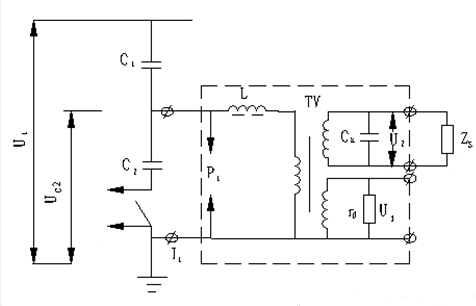Although CVT ratio doesn’t be listed routine test item of IEC or other international standards. Since simple and lower cost, we don’t deny its importance. Actually, to accept CVT by its ratio in the field is widely accepted by international clients around the world.
1.Principle of capacitor dividers
Capacitor voltage transformer is one capacitor divider. It consists of two parts, main capacitor/HV capacitor C1 and dividing capacitor C2. Refer Fig.1 for reference.

Fig.1 CVT Principle
While CVT is applied on high voltage U1, then its capacitor will get voltage Uc2.
U1=Uc1+ Uc2
Uc1=C2* U1/(C1+C2), Uc2=C1* U1/(C1+C2), C1/(C1+C2)=K, named capacitor ratio;
Change C1 and C2, different K value is got.
Since Uc2 is in direct proportion to U1. Therefore, we could get U1 if we could measure Uc2.
That is CVT principle.
2.CVT Capacitor Ratio Vs Voltage Ratio
It is important to note that the capacitor ratio and voltage ratio of CVTs are two different things.
For CVT, its Capacitor ratio K= C1/(C1+C2)
However, CVT Voltage Ratio follows the concept of traditional voltage ratio. To be specific CVT Voltage Ratio =U1/U2. U1 is CVT rated phase voltage, U2 is the secondary voltage of CVT intermediate transformer.
3. CVT Voltage Ratio to be measured
3.1 Why test voltage is up to 10KV for CVT voltage ratio measured
Different from electromagnetic PTs, CVT measure high voltage based on capacitor ratio.
Compared with electromagnetic PTs, CVT transient response is poor. Therefore, CVT voltage ratio couldn’t be measured by ordinary single phase transformer turns ratio tester.
Usually, CVT voltage ratio must be measured by special ratio meter which test voltage is up to 10KV. If you are interested in such topic, please visit our website http://www.xaapt.com/FAQ/Solutions-FAQ/Why-TTR-couldn%E2%80%99t-test-CVT-Ratio?id=14 for detail.
3.2 Two different test machine for CVT voltage ratio measured
To measure CVT voltage ratio, there are two kinds of test machine available.
One is traditional single phase transformer turns ratio tester with up to 10KV test voltage, such as Doble capacitor voltage transformer tester, model CVT765;
Another is measured by special tgδ test.
Actually, whether traditional single phase transformer turns ratio tester with up to 10KV test voltage or special tgδ test, their test principle are complete same. Test items are same also, includes CVT voltage ratio, phase & error, and polarity.
CVT765 | DF902F or DF4902F | |
CVT Voltage Ratio Range and its accuracy | 75-5,000 (±0.25%), 5,001-10,000 (±0.35%), 10,001-15,000 (±0.5%) | 10~99999, ±reading×1% |
Phase angle and its accuracy | 0~ 360 degrees | 0~359.999° ±0.02° |
Polarity | Yes | Yes |
Electromagnetic PT | Yes | Yes |
CVT Capacitance and tgδ | No | Yes |
![1676273314835720.png A$AV6$2PXB3UA(G30S]HZRK.png](https://apt-image.oss-cn-hongkong.aliyuncs.com/766761bd75610e1c61808a7ce9dfa693-20230213.jpg)
Fig.2 CVT Voltage Ratio measure
Fig.2 is CVT voltage ratio tested by Model DF902F.
4. Our recommendation
Compared to single phase transformer turns ratio tester, we recommend special tgδ tester.
4.1 What is special for CVT tgδ tester
Compared to ordinary tgδ tester, CVT tgδ tester increase new source to measure CVT’s capacitance and tgδ. Ie, C1 & tgδ1, C2 & tgδ2
To measure CVT voltage ratio with tgδ tester 10KV source.
4.2 Why we commend CVT tgδ tester
The most important, CVT tgδ tester could perform CVT capacitance and tgδ. And TTR can’t. CVT capacitance and tgδ measurement are listed its top two routine test items for IEC standards;
More cost-effective. CVT tgδ tester measures CVT voltage ratio by its own 10KV source. However, single phase TTR must increase 10KV source to test CVT;
Safer for the operator.
comments
LEAVE A COMMENT